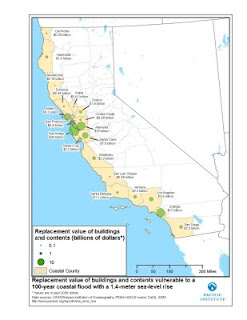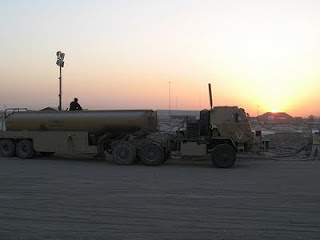-
Climate Change Is Linked to Security, But Don’t Overplay It
›August 31, 2009 // By Wilson Center StaffAs the impacts of climate change on national security are beginning to receive attention at the highest levels of government, climate-security experts must avoid oversimplifying these complex connections, said Geoff Dabelko, director of the Environmental Change and Security Program at the Woodrow Wilson Center.
“Today, with climate change high on the political agenda, powerful actors in the security community are assessing its potentially dangerous effects on conflict and military readiness,” Dabelko said. In “Planning for Climate Change: The Security Community’s Precautionary Principle” in the journal Climatic Change, Dabelko views the defense community’s interest in climate change as an understandable development. “Climate change poses threats and opportunities that any risk analysis calculation should take seriously—including the military’s planning efforts, such as the Quadrennial Defense Review,” he says.
“However, it is important to remember that in the mid-1990s, advocates oversold our understanding of environmental links to security, creating a backlash that ultimately undermined policymakers’ support for meeting the very real connections between environment and conflict head-on. Today, ‘climate security’ is in danger of becoming merely a political argument that understates the complexity of climate’s security challenges.”
In a new op-ed in the Bulletin of the Atomic Scientists, Dabelko offers some advice to scientists, politicians, and the media:- Don’t oversimplify the links between climate change and violent conflict or terrorism.
- Don’t neglect ongoing natural resource and conflict problems.
- Don’t assume we know the precise scale and location of climate-induced migration.
- Don’t forget that climate mitigation efforts can introduce social conflict and needs to be factored into both mitigation and adaptation efforts.
-
Weekly Reading
›Christian Aid’s “Growing Pains: The Possibilities and Problems of Biofuels” finds that “huge subsidies and targets in developed countries for boosting the production of fuels from plants such as maize and palm oil are exacerbating environmental and social problems in poor nations.”
Framing the climate change debate in terms of national security could help advance climate legislation in Congress, argues a New York Times editorial, one week after its front-page article on the topic. In letters to the editor, James Morin of Operation FREE calls climate change the “ultimate destabilizer,” and retired Vice Admiral Lee Gunn warned that the “repercussions of these changes are not as far off as one would think.”
Researchers at Purdue University’s Climate Change Research Center found that climate change could deepen poverty, especially in urban areas of developing countries, by increasing food prices. “While those who work in agriculture would have some benefit from higher grains prices, the urban poor would only get the negative effects.” Of the 16 countries studied, “Bangladesh, Mexico and Zambia showed the greatest percentage of the population entering poverty in the wake of extreme drought.”
India’s 2009 State of the Environment Report finds that almost half of the country’s land is environmentally degraded, air pollution is increasing, and biodiversity is decreasing. In addition, the report points out that almost 700 million rural people—more than half the country’s population—are directly dependent on climate-sensitive resources for their subsistence and livelihoods. And furthermore, “the adaptive capacity of dry land farmers, forest dwellers, fisher folk and nomadic shepherds is very low.”
Surveys completed by a Cambodian national indigenous peoples network find that “five million hectares of land belonging to indigenous minority peoples [have] been appropriated for mining and agricultural land concessions in the past five years,” reports the Phnom Penh Post.
The Economic Report on Africa 2009 warns that despite declining food prices, “many African countries continue to suffer from food shortage and food insecurity due to drought, conflicts and rigid supply conditions among other factors.” -
Budgeting for Climate
› Update: Read a response by Miriam Pemberton
Update: Read a response by Miriam Pemberton“The Obama administration…has identified the task of substantially reducing greenhouse gas emissions as one of its top priorities,” writes Miriam Pemberton in a new report from the Institute for Policy Studies, “Military vs. Climate Security: Mapping the Shift from the Bush Years to the Obama Era.”
-
Demography and Democracy in Iran
›August 12, 2009 // By Brian Klein President Mahmoud Ahmadinejad might have blamed sinister “foreign powers” for fomenting post-election civil unrest in Iran, but some analysts have fingered another culprit: demography. According to Farzaneh (Nazy) Roudi, program director for the Middle East and North Africa at the Population Reference Bureau, two phenomena “provide a backdrop for understanding Iran’s current instability.” First is the country’s youthful population age structure, or “youth bulge”; over 30 percent of Iranians are between the ages of 15 and 29, and 60 percent are under the age of 30. Second is Iran’s surprisingly comprehensive family planning program, which has empowered women to make their own reproductive choices and enter higher education en masse.
President Mahmoud Ahmadinejad might have blamed sinister “foreign powers” for fomenting post-election civil unrest in Iran, but some analysts have fingered another culprit: demography. According to Farzaneh (Nazy) Roudi, program director for the Middle East and North Africa at the Population Reference Bureau, two phenomena “provide a backdrop for understanding Iran’s current instability.” First is the country’s youthful population age structure, or “youth bulge”; over 30 percent of Iranians are between the ages of 15 and 29, and 60 percent are under the age of 30. Second is Iran’s surprisingly comprehensive family planning program, which has empowered women to make their own reproductive choices and enter higher education en masse. -
Going Back to Cali–or Chennai: Cities Should Plan For “Climate Migration”
›August 6, 2009 // By Elizabeth Hipple On Monday, California became the first U.S. state to issue a report outlining strategies for adapting to climate change. Among other recommendations, it suggests that Californians should consider moving.
On Monday, California became the first U.S. state to issue a report outlining strategies for adapting to climate change. Among other recommendations, it suggests that Californians should consider moving. -
Senate, Pentagon Focus on Climate-Security Challenges
›July 31, 2009 // By Brian Klein “Climate change may well be a predominant national security challenge of the 21st century, posing a range of threats to U.S. and international security,” said Sharon Burke, vice president for Natural Security at the Center for a New American Security (CNAS). Her remarks at a July 21 Senate Foreign Relations Committee hearing on climate change and security—along with those of two retired vice admirals and former Senator John Warner—amplified the growing chorus of national security experts and military personnel urging Congress to act promptly to address the security implications of climate change.
“Climate change may well be a predominant national security challenge of the 21st century, posing a range of threats to U.S. and international security,” said Sharon Burke, vice president for Natural Security at the Center for a New American Security (CNAS). Her remarks at a July 21 Senate Foreign Relations Committee hearing on climate change and security—along with those of two retired vice admirals and former Senator John Warner—amplified the growing chorus of national security experts and military personnel urging Congress to act promptly to address the security implications of climate change.
Vice Admiral Lee Gunn, USN (Ret.), called climate change “a clear and present danger to the United States of America,” while Burke cited a 2007 report from the Center for Naval Analysis that defined climate change as a “threat multiplier.”
Security Link Could Push Senate Climate Bill
Senator John Kerry, chair of the Senate Foreign Relations Committee, scheduled last week’s hearing on climate’s security links in a bid to bolster support for congressional action on climate change, which is currently stalled in the Senate. “Just as 9/11 taught us the painful lesson that oceans could not protect us from terror, today we are deluding ourselves if we believe that climate change will stop at our borders,” he said.
Former Senator John Warner echoed this sentiment, noting that the hearing was an opportunity to “educate the American public on these potential risks to our national security posed by global climate change.”
“Leading military, intelligence, and security experts have publically spoken out that if left unchecked, global warming could increase instability and lead to conflict in already fragile regions of the world. If we ignore these facts, we do so at the peril of our national security and increase the risk to those in uniform who serve our nation,” stated Warner, who recently launched the Pew Project on National Security, Energy, and Climate with the Pew Environment Group.
Pentagon Looks to Reduce Reliance on Oil and Drive Innovation
Burke explained that the phenomenon will not only pose “direct threats to the lives and property of Americans” from wildfires, droughts, flooding, severe storms, the spread of diseases, and mass migrations, but will also have “direct effects on the military,” including problems with infrastructure and the supply chain.
As a massive consumer of energy—110 million barrels of oil and 3.8 billion kilowatts of electricity in 2006 alone—the Pentagon has recognized its vulnerability to disruptions in fossil fuel supplies, as well as its potential to develop alternative technologies. As ClimateWire’s Jessica Leber writes in the New York Times: “The long logistics ‘tail’ that follows troops into the war zone—moving fuel, water and supplies in and waste out—risks lives and diverts major resources from fighting.”
According to Leber, two-thirds of the tonnage in Iraq convoys was fuel and water. To mitigate such vulnerability in the future—not to mention in arid, mountainous Afghanistan—DoD has begun testing ways to turn waste into energy, distribute power through “microgrids,” develop jet fuel from algae, desalinate water using little energy, and purify wastewater on a small scale.
“While the military by itself won’t make a market for plug-in vehicles or algae-based jet fuel,” notes Leber in an earlier ClimateWire article, “its investment power can bump emerging climate-friendly technologies onto a larger commercial stage.”
At the hearing, Burke warned against the possible knock-on effects of switching dependence from fossil fuel to other resources like lithium for lithium-ion batteries in electric cars.
The Military Must Manage Uncertainty
Vice Admiral Dennis McGinn, USN (Ret.), a member of the CNA’s Military Advisory Board, dismissed the argument that climate data and projections are too uncertain to form a solid basis for action. “As military professionals,” he told the Senate committee, “we were trained to make decisions in situations defined by ambiguous information and little concrete knowledge of the enemy intent. We based our decisions on trends, experience, and judgment, because waiting for 100% certainty during a crisis can be disastrous, especially one with the huge national security consequences of climate change.”
“The future has a way of humbling those who try to predict it too precisely,” Kerry said at the hearing. “But we do know, from scientists and security experts, that the threat is very real. If we fail to connect the dots—if we fail to take action—the simple, indisputable reality is that we will find ourselves living not only in a ravaged environment, but also in a more dangerous world.”
Photo: A convoy of the U.S. Army’s 515th Transportation Division moves fuel around Baghdad, Iraq. Courtesy Flickr user heraldpost. -
Weekly Reading
›“The natural resources are being depleted at an alarming rate, as population pressures mount in the Arab countries,” says the 2009 Arab Human Development Report, which was published this week by the UN Development Programme. A launch event in Washington, DC, features New York Times columnist Tom Friedman and Wilson Center scholar Robin Wright.
A special issue of IHDP Update focuses on “Human Security in an Era of Global Change,” a synthesis report tied to the recent GECHS conference. Articles by GECHS members, including Karen O’Brien and Alexander Lopez, address water and sanitation, the global financial crisis, poverty, and transborder environmental governance in Latin America.
An op-ed by Stanley Weiss in the New York Times argues that the best way to bring water–and peace–to the Middle East is to ship it from Turkey. A response by Gabriel Eckstein in the International Water Law Project blog argues that “transporting water from Turkey to where it is needed will require negotiations of Herculean proportion.”
CoCooN, a new international program sponsored by The Netherlands on conflict and cooperation over natural resources, recently posted two powerpoint presentations explaining its goals and the matchmaking workshops it will hold in Addis Ababa, Bogota, and Hanoi. The deadline for applications is August 5.
Two new IFPRI research papers focus on the consequences of climate change for poor farmers in Africa and provide policymakers with adaptation strategies. “Economywide Impacts of Climate Change on Agriculture in sub-Saharan Africa” analyzes two possible options for the region. “Soil and Water Conservation Technologies: A Buffer Against Production Risk in the Face of Climate Change?” investigates the impact of different soil and water conservation technologies on the variance of crop production in Ethiopia. -
Summer in the City: Water Supplies Fall and Tempers Flare in South Asia
›July 22, 2009 // By Elizabeth HippleThree people died in the city of Bhopal, in north-central India, in a battle between neighbors for scarce water, The Guardian reported this past week. Fights regularly broke out when the water tankers that serve 100,000 of the city’s residents make their deliveries.
Fights regularly broke out when the water tankers that serve 100,000 of the city’s residents make their deliveries.
The monsoon this year produced less rain than usual, exacerbating a drought. In addition, the number of people in Bhopal’s slums is growing. “The population has increased, but the water supply is the same,” a local committee chairman told The Guardian.
The northern parts of India were hardest hit, but much of India experienced similar conditions, including the city of Mumbai. Officials there cut water supplies for the city by 30 percent when the levels of the five lakes that serve as Mumbai’s primary sources of water dropped dangerously low.
But while heavy rains in the last few days mostly restored supplies, they also shut down the waterlogged city, reviving fears of 2005’s deadly floods. According to a new book and exhibit by University of Pennsylvania architects, the sprawling city has paved over the mangrove wetlands that protect it from flooding.
Pollution, climate change, population growth, urbanization, and industrialization in the world’s developing countries continue to increase demand for its finite water supplies. Today, 700 million people live in countries experiencing water scarcity or stress; by 2035, that figure is expected to have reached 3 billion people, or almost half of the world’s population. Asia, with 60% of the world’s population but only 36% of the world’s freshwater, will be particularly hard hit.
The problems vary across South Asia. The rivers around Dhaka, Bangladesh, are so polluted from industrial dumping that specialists are saying the situation is beyond repair. Lack of access to clean water and knowledge about hygienic sanitation practices leads to thousands of preventable deaths from diarrhea every year in Nepal. In Karachi, Pakistan, stealing public water out of pipes and tankers is a $500 million industry, “a mark of the state’s decreasing capacity to provide for its own,” reports Bill Wheeler in a special report in GOOD magazine.
The Indus Waters Treaty of 1960 between India and Pakistan has long been hailed as an example of the cooperation that can result from the necessity of sharing such an essential resource across borders. But with climate change causing the Himalayan glaciers that feed the Indus River to melt at a faster pace, some experts warn that balancing the water needs of both countries across their contested border could be a trigger point for conflict—particularly for two nations that cannot provide many of their citizens with access to safe drinking water under normal circumstances.
South Asian governments will be called upon more and more to balance the water of needs between different users at the local level and work with other governments to share and conserve water at the international level. But as Ashok Jaitly of New Delhi’s Energy and Resources Institute told Wheeler, both India and Pakistan share a “mentality that obscures the need to manage demand with conservation, water tariffs, and an end to destructive but politically popular practices in both countries.”
Despite the recognition of water as a growing security issue by the international community, it is difficult to improve what is a symptom of deeper-set problems. But they must try, if only for their own security. As Pakistan President Asif Ali Zardari warned in a Washington Post op-ed, “The water crisis in Pakistan is directly linked to relations with India. Resolution could prevent an environmental catastrophe in South Asia, but failure to do so could fuel the fires of discontent that lead to extremism and terrorism.”
By Comparative Urban Studies Project intern Elizabeth Hipple and edited by Meaghan Parker
Photo: The Ganges River in Varanasi, India. Courtesy flickr user Denver Pam
Showing posts from category conflict.



 President Mahmoud Ahmadinejad might have blamed sinister “
President Mahmoud Ahmadinejad might have blamed sinister “ On Monday, California became the first U.S. state to issue a
On Monday, California became the first U.S. state to issue a  “Climate change may well be a predominant national security challenge of the 21st century, posing a range of threats to U.S. and international security,” said
“Climate change may well be a predominant national security challenge of the 21st century, posing a range of threats to U.S. and international security,” said  Fights regularly broke out when the water tankers that serve 100,000 of the city’s residents make their deliveries.
Fights regularly broke out when the water tankers that serve 100,000 of the city’s residents make their deliveries.

